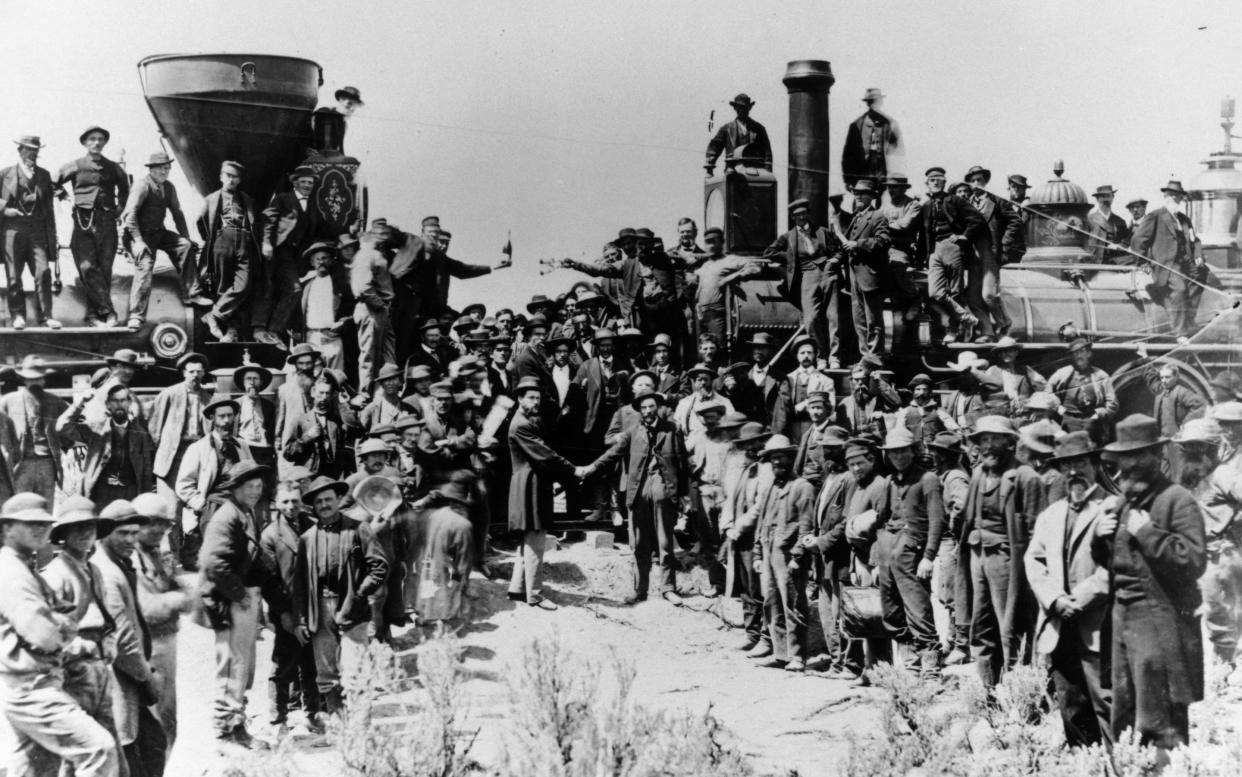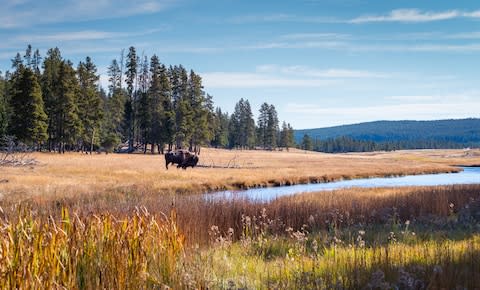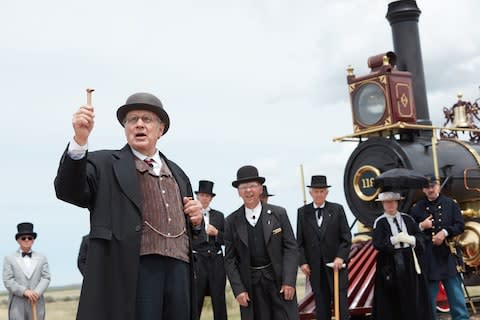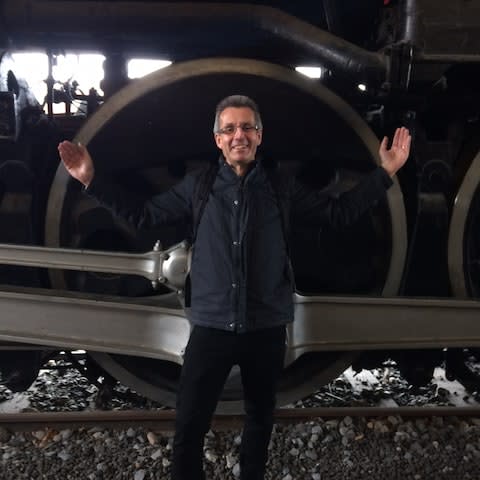The engineering marvel that tamed the Wild West

I learnt a new word during a brief stopover in Ogden, a settlement once synonymous with sin a few miles to the north of Salt Lake City in the western state of Utah – “Foamers”.
I will return to the subject of sin, but for now, “foamers”. These, I was told, are people who “foam at the mouth” excitedly at the thought of trains and railways and huge locomotives of the sort on display at the wonderfully grand Union Station at the top of Ogden’s infamous 25th Street.
There are going to be a lot of foamers in Ogden over the coming days as Americans celebrate the 150th anniversary of the epoch-changing moment on May 10 1869 when teams of competing workmen laying rail tracks coming from east and west met at the spot known as Promontory Summit, 50 miles north of Ogden.
The festivities will not simply be for foamers: although trains are not the force they once were in America, they played a key role in the history of the country and still occupy a very special place in the national psyche. Over the next few weeks, and the rest of what Utah is calling the “Year of the Train”, there will be commemorations and exhibitions, street parties and performances and fresh reflections on what was at the hailed as the “great work of modern America”.
It is hard to underestimate the significance of the coming of the Transcontinental Railroad, a gargantuan task that had taken almost six years to complete, had cost more than $60 million (a fortune in the 1860s) and employed a workforce consisting of Irish, Scandinavian, Chinese, Mormons – and newly freed slaves from the southern states. The construction had also sparked an intense rivalry between the competing teams – those coming from the eastern city of Omaha under the banner of the Union Pacific Railroad and those from Sacramento in the west of the Central Pacific – racing to reach the meeting point and to claim the lucrative sums being paid for each of the 1,776 miles of track laid.
In one fell swoop – or one fell blow to the golden “spike” that secured the final stretch of track at Promontory Summit – the cities on the eastern, Atlantic side of the country were connected by rail to those on the Pacific in the west, and the journey between New York and San Francisco and the gold-rich state of California, previously a perilous affair taking several months by ox-drawn wagon or ship (around Cape Horn), had been cut to less than a week.
The Transcontinental signalled the end of what had been known as the Frontier lands and sparked a massive influx into the hitherto uncharted territories of the “Wild West”. It united a nation sorely bruised by a civil war that had only recently ended and gave a much-needed shot of hope and can-do confidence. It provided the stuff of legends and inspiration and brought trade, prosperity and untold opportunity to countless thousands – though not, it has to be said, the American Indian tribes such as the Sioux and Cheyenne for whom the coming of the “Iron Horse” spelt the end of an age-old way of life of roaming the plains of the west and living off the herds of buffalo, now being systematically killed off by the likes of William F Cody, aka “Buffalo Bill”.

The depiction of this history at Promontory Summit itself is unashamedly celebratory. An introductory film in the visitor centre lauds the prowess of a feat “never before equalled in railroad history” and the “spanning of a continent”, while titles in the DVD collection include The Railroads that Tamed the West. Grainy black and white photographs and displays recount the tales of derring-do – the feats of bravery displayed by the Chinese workers who put themselves in considerable danger blasting a way through the granite of the Sierra Nevada; the blood, sweat and brawn of the labourers of the Central Pacific workforce who laid a record 10 miles (16km) of track in a single day; the perils faced by advance parties of the Union Pacific who came under repeated attack from American Indians and who themselves faced the immense challenge of finding a way through the Rockies.

There are references, too, to Abraham Lincoln, the visionary president who in 1862 signed the act authorising the construction of the railroad between California and the lands west of the Missouri river, and the iconic photograph taken by Andrew J Russell capturing the moment the prize locomotives of the two rail companies – the Jupiter and the No 119 – stood face to face surrounded by the men who had made it happen. (Or some of them: there are no Chinese faces in the photo: although they proved excellent workers, the Chinese were paid less and treated differently.)
Outside, against the snow-capped mountain-fringed backdrop of the starkly beautiful landscape of northern Utah, you can stand on the very spot where that golden spike was struck and try to imagine the scene 150 years ago and the joy it occasioned – news of the breakthrough was signalled to an eagerly waiting nation live courtesy of the telegraph wires that had been constructed alongside the track; church bells pealed and cannons fired across the now truly United States.

If you happen to be there next Friday, gleaming replicas of the Jupiter and No 119 locomotives will be in situ and something of the drama of that day in 1869 will be recreated before an anticipated audience of at least 10,000.
On the day I was there, a crisp spring morning early last month, small clusters of the curious wandered out to walk the tracks and explain to children who had never perhaps taken a train ride the significance of what had happened here all those years ago.

From there, some embarked on drives following the contours of the track laid back then. I preferred the walking option: the “Big Fill Trail”, a one-and-a-half mile loop that graphically brought home the ruggedness of the terrain through which the tracks had to be laid – “Rattlesnakes have right of way”, I read on one sign – and the scale of the competition (at one point there are parallel lines within sight of each other that were laid by Union Pacific and Central Pacific crews).
I was alone with my thoughts as I contemplated the huge logistical difficulties that had to be overcome in crossing the Spring Creek Ravine – one side attempted a huge trestle bridge, the other a large landfill – but then I bumped into a couple of fellow walkers, Mormons as it happened, who revealed that as avid bird watchers they also hoped to catch sight of the pelicans drawn to the briny waters of the salt pans in the vast empty valley below.

It has been many decades since Promontory Summit served as a functioning station, its role as the key terminus for the region having been transferred very early on to the city of Ogden to the south. Which leads neatly back to the subject of sin.
“There was a time when every vice known to man could be located within a two-block radius of the Ogden Union Depot,” said Sarah Singh, a curator at the Weber State University in Ogden and a specialist in the city’s colourful history. “Oh yes, you name it – drinking, gambling, prostitution, street fighting and opium dens… we had it all here. The madams of 25th Street were legendary. With her pink Cadillac and ursulet cat, Rose Davy was very striking.”
I meet Sarah at the Roosters Brewing Company, and although it is only lunchtime, enjoy a couple of its very flavoursome crafted beers (they don’t call it “sin city” for nothing).
I had come directly from the station, a temple to the golden age of rail in America, which at its Forties/Fifties peak served as a main junction for trains crossing the country from east to west and north to south and dealt with some 100,000 passengers a day.
Many coming through Ogden had hours to kill and the enterprising residents of the town lost no opportunity in providing diversion.
At one point 25th Street boasted 89 bars, numerous brothels and so intense was the brawling that on a journey through Ogden the famous gangster Al Capone allegedly decided not to venture into town as it looked too wild even for him.
The story is no doubt apocryphal, but it adds to the allure of a city that for almost a century occupied a special place in American travelling folklore and was the ultimate manifestation of the “Hell on Wheels” towns of infamy that sprang up along the railroad.
What a contrast to today. That magnificent station is now almost completely silent, its multiple tracks serving only the occasional freight train and a solitary passenger service down to Salt Lake City. The community, though, is proud of its rail heritage and has fought to preserve the station, part of which is now home to an excellent museum highlighting the history and the heyday – the story of the Transcontinental, of course, but beyond that the stories of the soldiers who came through Ogden during the Second World War and liked the look of those surrounding snow caps; the stories of the black attendants who were employed to serve in luxurious Pullman carriages but also played in jazz clubs that began to challenge the strictures of segregation and even welcomed the likes of the legendary Louis Armstrong.
Glamorised advertisements promote the joys of the first sleeper cars that ushered in a wonderful new way of relaxing and exploring the continent. Outside there are carriages from the golden age that can be boarded and locomotives bearing iconic names such as “Big Boy”. Children stare wide-eyed, though for many, these monuments to engineering prowess feel almost as remote as the displays of dinosaurs to be found in the Natural History Museum of Utah in Salt Lake City.

The advent of air travel and the mass-produced car utterly transformed the way Americans chose to travel and by the Sixties, Ogden found itself going into a steep decline as fewer and fewer people opted to travel by train. There were many years in the doldrums, but in the past couple of decades the city has been reinventing itself as a place of gastro eateries and craft beers; street events and galleries (there are some nice rail murals on display at the moment). And it still unashamedly celebrates its rail-inspired racy past.
“We remain untamed,” says Visit Ogden’s Sydnie Furton. “Our motto is ‘notoriously independent’.”
I catch the spirit of that on a stroll along what is now a much cleaned up 25th Street. Just along from the building boasting the sign “London Ice Cream Parlour” (ahem), I spot the Endless Indulgence store specialising in all things retro. A poster in the window heralds the coming celebrations of the Transcontinental and exhorts the town’s citizens to “Come Party like it’s 1869”.
I’m sure the good folk of Ogden – to say nothing of the scores of foamers – will this weekend be doing just that.
Adrian Bridge travelled as a guest of the Utah Office of Tourism
Spike 150
The highlight of the Spike 150 Sesquicentennial Celebration Festival will take place next weekend (May 10-12) at Promontory Summit, but there are a host of events and related exhibitions taking place in Utah over the rest of the year: spike150.org/statewide-events
Where to stay
The Bigelow Hotel (bigelowhotelogden.com). Built in 1891, this Ogden icon was one of Utah’s grandest hotels in the Twenties and is the only one that survives from those times. Doubles from $99 (£75).
What to see
The Race to the Promontory is a display of photographs taken during the construction of the Transcontinental Railroad. At the Utah Museum of Fine Arts in Salt Lake City until May 26: umfa.utah.edu


